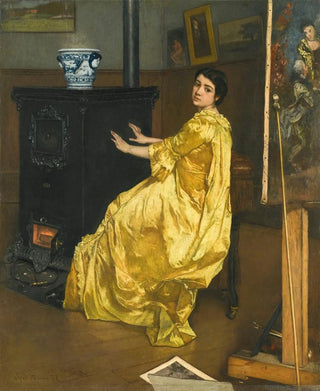Art print | In the studio, the model's rest - Alfred Stevens


View from behind

Frame (optional)
In the fascinating world of art, some works manage to capture the very essence of creativity and intimacy. "Dans l'atelier le repos du modèle" by Alfred Stevens is one of those iconic pieces that transport the viewer to the heart of the artist's studio. This scene, bathed in soft and warm light, reveals a moment of pause, a suspended moment where the model, both muse and protagonist, rests after a pose. Stevens' delicate composition, both realistic and poetic, invites silent contemplation, where every detail seems to whisper a forgotten story.
Style and uniqueness of the artwork
The piece stands out for its refined approach and meticulous attention to detail. Stevens, a master of the genre, manages to create an intimate atmosphere where the beauty of the model blends with the richness of textures and colors. The subtle play of light, filtering through the studio windows, highlights the delicate curves of the female silhouette, while emphasizing the depth of shadows. Every element of the canvas, from the drapery of the fabric to scattered accessories, contributes to the overall harmony of the scene. Stevens does not merely depict a moment; he evokes an emotion, a deep connection between the artist and his model, as well as a reflection on the creative process itself. This painting is a tribute to the act of painting, to the beauty of representation, and to the importance of rest in artistic inspiration.
The artist and his influence
Alfred Stevens, a prominent figure of the 19th century, established himself as a pioneer in the field of genre painting. Influenced by Renaissance masters and the innovations of the Impressionists, he developed a unique style that combines realism and sensitivity. Stevens, as a Belgian artist, also played a crucial role in the artistic dialogue between France and Belgium, thereby enriching the European cultural landscape. His work has inspired many contemporary artists, who saw in him a model of integrating everyday life into art. Through his bold stylistic choices and commitment to representing femininity, he

Matte finish

View from behind

Frame (optional)
In the fascinating world of art, some works manage to capture the very essence of creativity and intimacy. "Dans l'atelier le repos du modèle" by Alfred Stevens is one of those iconic pieces that transport the viewer to the heart of the artist's studio. This scene, bathed in soft and warm light, reveals a moment of pause, a suspended moment where the model, both muse and protagonist, rests after a pose. Stevens' delicate composition, both realistic and poetic, invites silent contemplation, where every detail seems to whisper a forgotten story.
Style and uniqueness of the artwork
The piece stands out for its refined approach and meticulous attention to detail. Stevens, a master of the genre, manages to create an intimate atmosphere where the beauty of the model blends with the richness of textures and colors. The subtle play of light, filtering through the studio windows, highlights the delicate curves of the female silhouette, while emphasizing the depth of shadows. Every element of the canvas, from the drapery of the fabric to scattered accessories, contributes to the overall harmony of the scene. Stevens does not merely depict a moment; he evokes an emotion, a deep connection between the artist and his model, as well as a reflection on the creative process itself. This painting is a tribute to the act of painting, to the beauty of representation, and to the importance of rest in artistic inspiration.
The artist and his influence
Alfred Stevens, a prominent figure of the 19th century, established himself as a pioneer in the field of genre painting. Influenced by Renaissance masters and the innovations of the Impressionists, he developed a unique style that combines realism and sensitivity. Stevens, as a Belgian artist, also played a crucial role in the artistic dialogue between France and Belgium, thereby enriching the European cultural landscape. His work has inspired many contemporary artists, who saw in him a model of integrating everyday life into art. Through his bold stylistic choices and commitment to representing femininity, he






